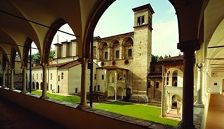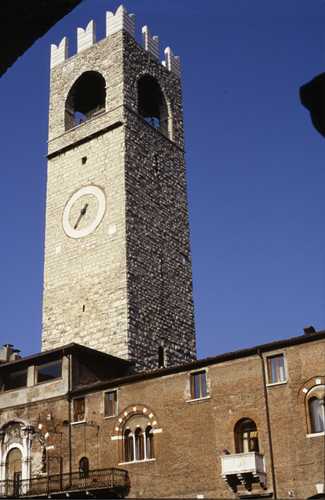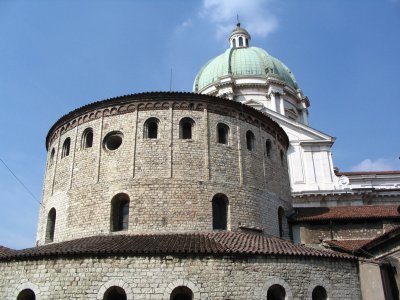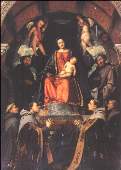Information about the Conference Venue
Brescia monuments
Additional info: http://www.bresciatourism.it
 Brescia: The Monastery of Santa Giulia
Brescia: The Monastery of Santa Giulia
This incredible museum is one of the most important complexes
of the early middle ages in Northern Italy. Founded in 753 by the Lombard King Desiderio, the monastery was
expanded several times until the Renaissance.
The complex contains the Basilica of San Salvatore, of Lombard origin, the Church of Santa Giulia, the Church of
Santa Maria in Solario, which houses the Treasure of Santa Giulia, and three Renaissance cloisters.
Three Roman villas were discovered under the larger cloister, the Domus dell�Ortaglia.
The monastery area was acquired by the Municipality, which has turned it into the �Museo della Citt�� where one
can follow the history of Brescia from the Bronze Age through to the Renaissance.The museum regularly hosts large art shows.
 Brescia: The Capitolium
Brescia: The Capitolium
The Capitolium, built by the emperor Vespasian in AD 73, was a religious site and the monumental centre of ancient Brixia.
The building was situated on the decumanus maximus (on the line of Via Musei) and was discovered in 1823.
It is a temple with three chambers, where the Capitoline trinity of deities was worshipped, and is based on the plan of
the underlying Republican temple. Inside marble fragments of an enormous male statue were found; others have come
to light recently. The most probable intriguing explanation is that these came from a sculpture of the enthroned
Capitoline Jupiter Optimus Maximus which dominated the central chamber; such a statue would have been modelled
on that in the Capitoline temple in Rome, copies of which were installed in religious buildings throughout the empire.
 Brescia: The Broletto
Brescia: The Broletto
This typical town hall, one of the most important in Lombardy, was built between 1187 and 1230, then expanded
in the 14th and 17th centuries. Many original parts still remain. Its name comes from brolo (vegetable garden)
or mercatum broli (vegetable market). The construction has incorporated several buildings, including the
15th century S. Agostino Church. Above it stands the Pegol Tower (53.7 m tall),
which is the oldest tower of the city (11th century). The months are depicted on two capitals of the four-light
window by the Anthelamica school on the southern side of the courtyard.
 Brescia: The New Cathedral
Brescia: The New Cathedral
Construction on this Late Renaissance Cathedral began in 1604 and was based on a project by G. B. Lantana.
Towering above it is the Cagnola Dome (with 80 meters in height inside, it is Italy's third largest
dome after Saint Peter's in Rome and Santa Maria Novella in Florence). It has three naves and a
Greek cross layout. The cathedral contains works by Romanino, Moretto, Maffei, Palma il Giovane,
Renaissance arches and sculptures by A. Calegari.
 Brescia: The Old Cathedral or Rotonda
Brescia: The Old Cathedral or Rotonda
This magnificent monument with a circular layout was built over the ruins of the S. Maria Maggiore.
Early Christian basilica by the Masters of Como towards the end of the 11th century. At the entrance
is the ornate tomb made of red Verona marble and dedicated to Berardo Maggi, Bishop of Brescia from 1298 to 1308;
beneath the presbytery is the San Filastrio crypt, with five naves and three apses.
It houses the Treasure of the Holy Crosses, including the Croce di Campo [The Cross of the Battlefield] (12th century),
which was raised on the Carroccio. There are also interesting paintings by Romanino and Alessandro Bonvicino,
named "il Moretto" (1526 ca.) and the Antegnati organ.
 Brescia: The Castle
Brescia: The Castle
Sitting at the top of the Cidneo Hill, the castle dates back to ancient times. Fortified since the Roman Era,
and probably a watchtower during the period of the Goths, it gradually took on its present aspect during
the Visconti dynasty in the first half of the 14th century. The keep has a cylindrical tower called the "Mirabella"
that is 22 meters tall and from the 13th century. More changes were made by the Venetians,
the French and the Austrians. Called "Falco d'Italia" [the Italian Falcon] due to its role in the Ten Days Revolt,
it has towers, ramparts, courtyards, drawbridges, and underground passages and rooms.
The castle is now the home of the Risorgimento Museum, the Museum of Weapons and the astronomical observatory.
 S. Francesco Church
S. Francesco Church
Dating back to the 13th century, the church has a splendid Romanesque - Gothic facade and a three nave
interior with frescoes from the 14th and 15th centuries, paintings by Moretto and Romanino,
a priceless wood tablet with Crucifix from the 14th century. A large processional cross
in embossed silver by G.F. delle Croci (1501) is among the masterpieces of Italian jeweler's art.
The adjacent Renaissance cloister from the late 15th century is made of red Verona marble.